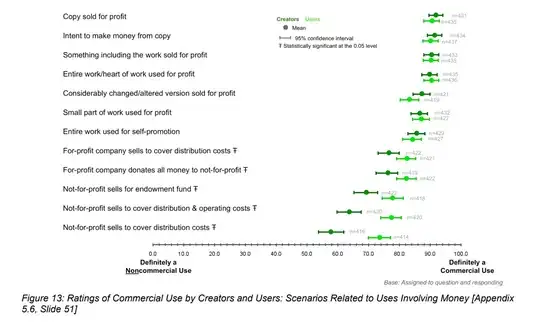Preface
I am Not a Lawyer, the stack does not give legal advice, consult a licensing lawyer and the maker to check your use is within the licensing agreeming or make a seperate one
The license CreativeCommons specifies BY-NC-SA as:
- BY = Attribute. You may share and modifiy it, as long as you tell who made it.
- NC = Non Commercial
- SA = Share Alike. You may not change the license
Non Commercial
The Non Commercial clause explained in the FAQ says:
CC's NonCommercial (NC) licenses prohibit uses that are "primarily intended for or directed toward commercial advantage or monetary compensation." [...] Whether a use is commercial will depend on the specifics of the situation and the intentions of the user.
[...] If you are unsure, you should either contact the rights holder for clarification, or search for works that permit commercial uses.
It also provides a CC-Wiki entry what NC is meant to be (pretty much the same as the FAQ), and a survey on it.
What is NC?
Ok, let's look at the NC part of the CC... When is something breaking the NC license? As soon as it is "primarily intended toward monetary gain" it is commercial (short version), and any commercial use is prhibited. What is this? well, let's read the report...
Specifically excluded from the prohibition against
noncommercial use in the NC licenses is the exchange of a CC-licensed work for
any other copyrighted work, whether by means of peer-to-peer digital file-sharing
or otherwise, provided no monetary compensation is involved.p.17
Most[significantly>50%] participants thought that “noncommercial use” had no
legal definition, or were not sure. Some[<50%] participants believed noncommercial use to be
more likely a fair use than not, and some conflated noncommercial use and fair
use. Some participants also mentioned personal or private use as being both
legally and pragmatically a noncommercial use, though they were not certain of
any law defining “personal use.”p.30
When asked to share their understandings of noncommercial use, no participant
could provide a definition of noncommercial use that worked for everyone in their
particular group, although there was much agreement on elements of many of
the definitions. Through discussion, it emerged that creators take a variety of
factors into account when determining what constitutes noncommercial use.
These factors are often considered on a case-by-case basis[...]p.30
However, participants across communities were able to articulate a list of factors
they generally agreed as a group were relevant to creators’ understanding of
whether a use of a work is commercial or noncommercial.p.31
Qualitative Research Consideration Factorsp.31
- Perceived economic value of the content
- The status of the user as an individual, an amateur or professional, a for-profit or
not-for-profit organization, etc.
- Whether the use makes money (and if
so, whether revenues are profit or recovery of costs associated with
use)
- Whether the use generates promotional value for the creator or
the user
- Whether the use is personal or private
- Whether the use is
for a charitable purpose or other social or public good
- Whether the
use is supported by advertising or not
- Whether the content is used in
part or in whole
- Whether the use has an impact on the market or is by
a competitor
Of particular interest are these paragraphs:
Creators in the groups recognized that they consider some factors more
important than others, and they also weigh the factors differently. Some consider
certain factors to be “gatekeeping” questions, the answer to which settles the
matter. Some creators consider a use commercial if there is any advertising in
connection with it, for example. Others consider certain factors to be questions of
degree. For example, some creators consider recovery of costs to distribute a
work a noncommercial use, but not if salaries or other overhead are calculated
as part of cost recovery. Rather than constituting a simple checklist, for many
creators the factors exist within a matrix in which the type of use (for example,
promotional or advertising use) and the context or community-based nature of
the use (for example, charitable use, or use in a public school) are important
vectors. In sum, the decision-making process is not clear-cut.p.32
In the quantitative surveys for both Phase 2 (creators) and Phase 3 (users), the
first mention of “noncommercial use” appears in an open-ended question asking
respondents how they would define the difference between a commercial use
and a noncommercial use of a work, in their own words and without consulting
other sources. Creators and users provided an answer in the same ratio –
approximately 7 in 10 from each group.p.49
A
large majority of both creators and users define a commercial use as one in
which money is made (73% of creators, 76% of users). [...] Neither group expresses a majority consensus on an
understanding of noncommercial use. [...] the most common mention of a
noncommercial use by both creators and users is some use by an individual
(19% of creators, 33% of users), including personal and private uses.p.50
Gatekeeping Factorsp.54

Making Money
The figure below provides a visual summary of the anchor point exercise
measuring responses to uses that make money.

On the question of making money for cost recovery, creators think covering
distribution costs only is slightly more commercial than covering operating costs,
or raising money for an endowment fund. Users tend to agree, but overall see
these uses as rather more commercial than creators.p.60
Conclusion
Contakt the maker that designed the part what is OK with them. But be warned: The broad idea the report gives is that around 3 of 4 of the makers and 4 of 5 users deem a "For Profit-Company selling [a thing] to cover distribution costs" as breaking the NC clause, as they deem it commercial use

